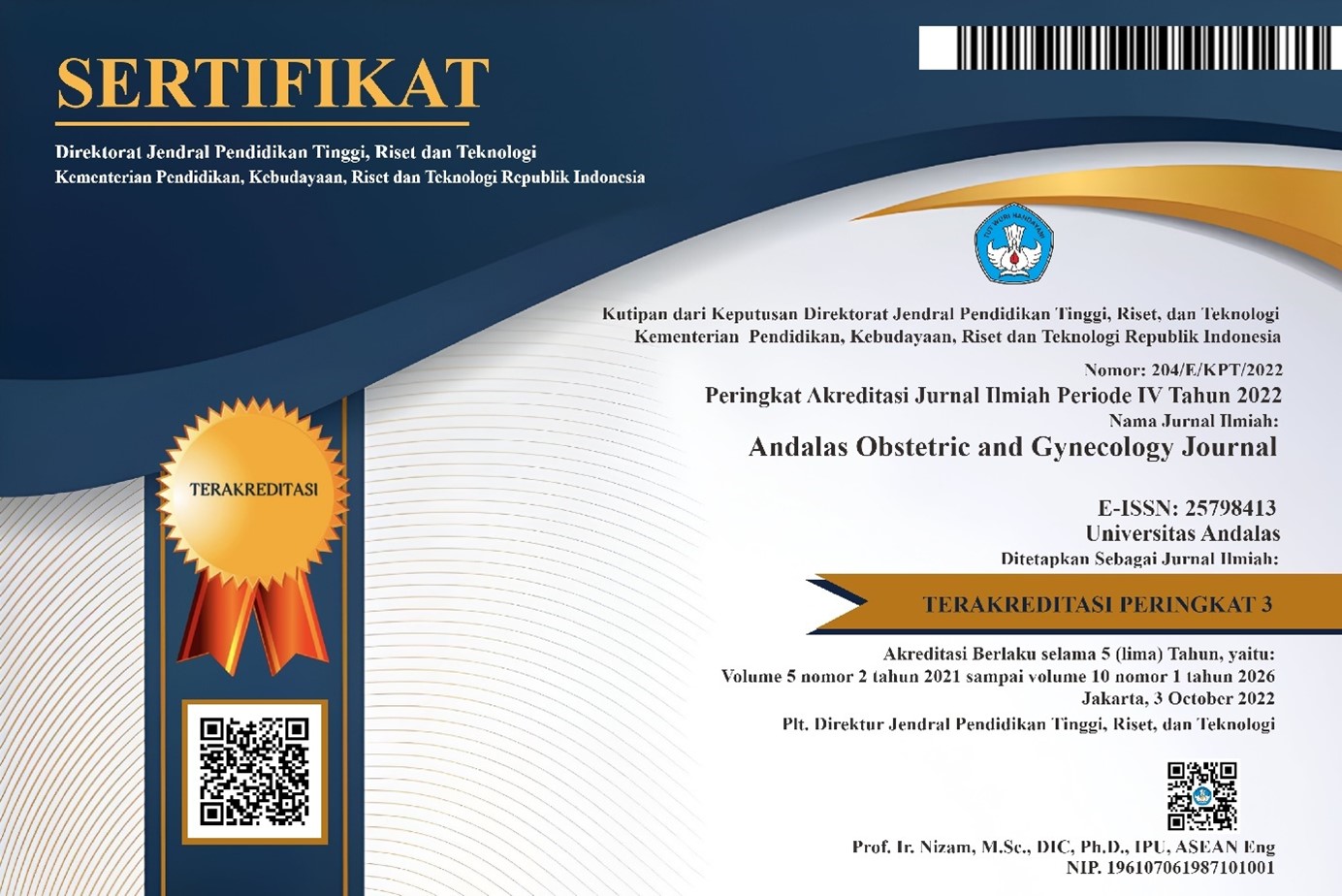The Difference in Average of Maternal Serum Hypoxia-Inducible Factors-1α Levels between Early Onset and Late-Onset Severe Preeclampsia
DOI:
https://doi.org/10.25077/aoj.5.1.82-89.2021Abstract
The purpose of this study is to know the difference average of maternal serum levels of HIF-1α between early-onset and late-onset severe preeclampsia. This study used a cross sectional comparative study design that conducted in Februari 2020 - Agustus 2020 in the SMF / Obstetrics and Gynecology department of RSUP dr. M. Djamil Padang, RSUD Achmad Mochtar, RSUD Pariaman, RSUD M Zein Painan. We used consecutive sampling method which consists of 60 pregnant women who fulfill the inclusion and exclusion criteria. They were divided into two groups early-onset severe preeclampsia and late-onset severe preeclampsia. HIF-1α tests were done using ELISA method. The average of maternal serum levels of HIF-1α in late-onset severe preeclampsia is found to be the highest when compared to the early-onset severe preeclampsia, 1,37 ± 1,08 ng/ml vs 0,69 ± 0,11 ng/ml. This difference is significant with the Mann-whitney non parametrical statistical test (p <0.05). There is a significant difference average of maternal serum levels of HIF-1α between early-onset and late-onset severe preeclampsia
Keywords: early onset severe preeclampsia, late onset preeclampsia late onset, maternal serum levels of HIF-1αReferences
Cunningham L, Bloom, Dashe. Hypertensive Disorders. Williams Obstetric 24 ed. New York: Mc Graw Hill; 2018. p.1086-8
ACOG. Hypertension in pregnancy. Washington : the American College of Obstetricans and Gynecologists; 2013.p. 22
Saito S. Preeclampsia, Basic, Genomic, and Clinical. Springer. 2018
Adhi Pribadi. Preeklampsia “Stoppableâ€. Sagung Seto. 2019
Sibai BM. Hypertension. In: Gabbe SG, Niebyl JR, Simpson JL, Landon MB, Galan HL, Jauniaux ERM, et al, editors. Obstetrics normal and problem pregnancies. 7th ed. Philadelphia: Elsevier; 2017. p. 661-705.
Raymond D, Peterson E. A Critical Review of Early-Onset and Late-Onset Preeclampsia. Obstetrical and Gynecological Survey by Lippincott Williams & Wilkins. 2011. Volume 66, Number 8.
Sriyanti R, Mose JC, Masrul, N. S. The difference in maternal serum Hypoxia-Inducible Factors-1a levels between early onset and late onset preeclampsia. Journal of Medical Science. 2019;7(13):2133-7.
Rath G, Aggarwa , Jawanjal P, Tripathi R, Batra A. HIF-1 Alpha and Placental Growth Factor in Pregnancies Complicated With Preeclampsia: A Qualitative and Quantitative Analysis. J of Clin Lab Anal. 2016; 30(75-83).
Wantania J, Bakri S, Pandelaki K, Chalid M. (2013). Altered level of Soluble fms-like Tyrosine Kinase 1 (sFlt1) and Hypoxia Inducible Factor-1α in Normotensive Pregnancy and Preeclampsia. Indones Biomed J 2013; 5(2):121-8.
Iriyama T, Wang , Parchim N, Song , Blackwell SC, Sibai B, et al. Hypoxia-Independent Upregulation of Placental Hypoxia Inducible Factor-1α Gene Expression Contributes to the Pathogenesis of Preeclampsia. Hyper AHA J. 2015 April.
Tal R. The Role of Hypoxia and Hypoxia-Inducible Factor-1Alpha in Preeclampsia Pathogenesis. Bio of Rep. 2012; 87(6).
Davutoglu EA, Firat AA, Ozel A, Yilmaz N, Uzun I, Yuksel IT, et al. Evaluation of maternal serum hypoxia inducible factor-1a, progranulin and syndecan-1 levels in pregnancies with early and late onset preeclampsia. The Journal of Maternal Fetal & Neonatal. 2017;2017:1-7.
Akhilesh M, Mahalingam V, Nalliah S, Ali RM, Ganesalingam , Haleagrahara N. Participation of hypoxia-inducible factor-1a in the pathogenesis of preeclampsia-related placental ischemia and its potential as a marker for preeclampsia. Biomarker and Genom Med. 2014 June; 6(121-125).
Bobek G, Surmon L, Mirabito KM, et al. Placental regulation of ınflammation and hypoxia after TNF-a ınfusion in mice. Am J Reprod Immunol. 2015;74: 407–418.
Caniggia I, Mostachfi H, Winter J, Gassmann M, Lye SJ, Kuliszewski M, Post M. Hypoxia-inducible factor-1 mediates the biological effects of oxygen on human trophoblast differentiation through TGFbeta(3). J Clin.Invest 2000; 105(5):577–587.
Galbiati S, Inversetti A, Causarano V, Stenirri S, Soriani N. HIF1A and MIF as potential predictive mRNA biomarkers of pre-eclampsia: a longitudinal prospective study in high risk population. Clin Chem Lab Med. 2015; 53(9).
Vermaa S, Pillay P, Naickerb T, Moodley J, Mackraj I. Placental hypoxia inducible factor -1a & CHOP immuno-histochemical expression relative to maternal circulatory syncytiotrophoblast micro-vesicles in preeclamptic and normotensive pregnancies. Euro J of Obs & Gyn Rep Bio. 2018; 220(18-24).
Liu W, Wang SJ, Lin QD. Study on the Expressions of PHD and HIF in Placentas from Normal Pregnant Women and Patients with Preeclampsia. Int. J. Biol. Sci.. 2014; 10
Rolfo A, Many A, Racano A, Tal R, Tagliaferro A, et al. Abnormalities in Oxygen Sensing Define Early and Late Onset Preeclampsia as Distinct Pathologies. PLoS ONE 2010; 5(10): e13288.
Galbiati S, Inversetti A, Causarano V, Stenirri S, Soriani N, Ambrosi A. HIF1A and MIF as potential predictive mRNA biomarkers of pre-eclampsia: a longitudinal prospective study in high risk population Clin Chem Lab Med. 2015;53(9):1339-47.
Downloads
Published
Issue
Section
License
Copyright (c) 2021 Andalas Obstetrics And Gynecology Journal

This work is licensed under a Creative Commons Attribution 4.0 International License.
Copyright
Authors who publish with this journal agree to the following terms:
- Authors retain the copyright of published articles and grant the journal right of first publication with the work simultaneously licensed under a Creative Commons Attribution 4.0 International License that allows others to share the work with an acknowledgment of the work's authorship and initial publication in this journal.
- Authors are able to enter into separate, additional contractual arrangements for the non-exclusive distribution of the journal's published version of the work (e.g., post it to an institutional repository or publish it in a book), with an acknowledgment of its initial publication in this journal.
- Authors are permitted and encouraged to post their work online (e.g., in institutional repositories or on their website) prior to and during the submission process, as it can lead to productive exchanges, as well as earlier and greater citation of published work (See The Effect of Open Access).
License:
Andalas Obstetrics and Gynecology Journal (AOJ) is published under the terms of the Creative Commons Attribution 4.0 International License. This license permits anyone to copy and redistribute this material in any form or format, compose, modify, and make derivatives of this material for any purpose, including commercial purposes, as long as they credit the author for the original work.







